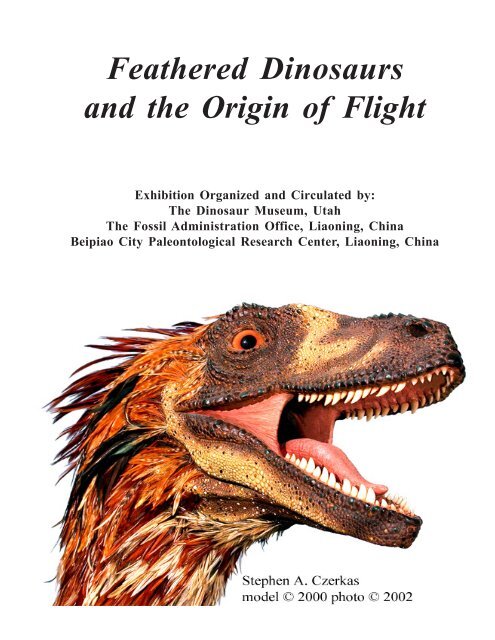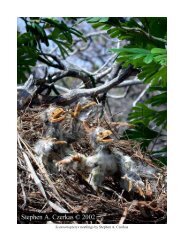Feathered Dinosaurs and the Origin of Flight - The Dinosaur Museum
Feathered Dinosaurs and the Origin of Flight - The Dinosaur Museum
Feathered Dinosaurs and the Origin of Flight - The Dinosaur Museum
You also want an ePaper? Increase the reach of your titles
YUMPU automatically turns print PDFs into web optimized ePapers that Google loves.
<strong>Fea<strong>the</strong>red</strong> <strong><strong>Dinosaur</strong>s</strong><br />
<strong>and</strong> <strong>the</strong> <strong>Origin</strong> <strong>of</strong> <strong>Flight</strong><br />
Exhibition Organized <strong>and</strong> Circulated by:<br />
<strong>The</strong> <strong>Dinosaur</strong> <strong>Museum</strong>, Utah<br />
<strong>The</strong> Fossil Administration Office, Liaoning, China<br />
Beipiao City Paleontological Research Center, Liaoning, China
THE PREHISTORIC WORLD OF LIAONING<br />
<strong>The</strong> fossils <strong>of</strong> Liaoning represent a complex ecosystem<br />
creating a more complete picture <strong>of</strong> this particular age <strong>of</strong><br />
dinosaurs than ever before. Life <strong>of</strong> <strong>the</strong> Early Cretaceous,<br />
120 million years ago, was far more than a world <strong>of</strong><br />
dinosaurs. <strong>The</strong> fossils include a remarkable variety <strong>of</strong><br />
plants, crustaceans, insects, fish, amphibians, lizards,<br />
crocodiles, aquatic reptiles, flying reptiles, as well as birds<br />
that could fly <strong>and</strong> o<strong>the</strong>rs which were flightless.
FEATHERS BEFORE BIRDS<br />
Included are graphics <strong>and</strong> photos which show developmental<br />
stages <strong>of</strong> fea<strong>the</strong>rs. <strong>The</strong> fossil <strong>of</strong> <strong>the</strong> flying reptile,<br />
Pterorhynchus is preserved with details <strong>of</strong> what pterosaurs<br />
looked like which have never been seen before. <strong>The</strong> body is<br />
covered with down-like fea<strong>the</strong>rs which resemble those also<br />
found on <strong>the</strong> dinosaur, Sinosauropteryx. Because fea<strong>the</strong>rs<br />
are now known to exist on animals o<strong>the</strong>r than birds, this<br />
discovery changes <strong>the</strong> definition <strong>of</strong> what a bird is.<br />
Sinosauropteryx<br />
Pterorhynchus
FLYING DROMAEOSAURS<br />
AND THE MISTAKEN IDENTITY<br />
Dromaeosaurs have been thought to be ground-dwelling<br />
dinosaurs that represented ancestral stages <strong>of</strong> how birds<br />
evolved. Fossils in this exhibit show that <strong>the</strong>y have been<br />
misinterpreted as dinosaurs when <strong>the</strong>y are actually birds.<br />
Fea<strong>the</strong>r impressions reveal that <strong>the</strong>y had flight fea<strong>the</strong>rs on <strong>the</strong><br />
wings <strong>and</strong> a second set on <strong>the</strong> hind legs. Even without <strong>the</strong><br />
fea<strong>the</strong>rs preserved, <strong>the</strong> avian characteristics <strong>of</strong> <strong>the</strong> skeleton<br />
demonstrate that <strong>the</strong>se dromaeosaurs are birds. This discovery<br />
means that <strong>the</strong> larger dromaeosaurs, like Deinonychus <strong>and</strong><br />
Velociraptor <strong>of</strong> “Jurassic Park” fame, were really fea<strong>the</strong>red<br />
<strong>and</strong> are secondarily flightless birds.
THE HIDDEN FLYER<br />
<strong>The</strong> discovery that dromaeosaurs such as Cryptovolans<br />
had flight fea<strong>the</strong>rs <strong>and</strong> were capable <strong>of</strong> flight means<br />
that <strong>the</strong>y had been misidentified as dinosaurs <strong>and</strong> not<br />
properly recognized as <strong>the</strong> birds that <strong>the</strong>y were. Even<br />
without <strong>the</strong> fea<strong>the</strong>rs preserved, <strong>the</strong> skeletal anatomy is<br />
comparable to that <strong>of</strong> Archaeopteryx which confirms<br />
that dromaeosaurs are birds.
THE FEATHER REVOLUTION<br />
Flying dromaeosaurs revealed that flightless dromaeosaurs were also birds <strong>and</strong> should not be portrayed as <strong>the</strong><br />
scaly dinosaurs as once thought. This suggests that o<strong>the</strong>r “dinosaurs” may actually be birds as well.
THE DIVERSITY OF BIRDS<br />
Flying <strong>and</strong> flightless birds, some with long tails<br />
or short, with teeth or beaked jaws, all represent<br />
a far greater world <strong>of</strong> birds than had been<br />
known before. This diversity allows for a<br />
better underst<strong>and</strong>ing <strong>of</strong> <strong>the</strong> relationship between<br />
birds <strong>and</strong> dinosaurs.
Caudipteryx, a flightless bird, or fea<strong>the</strong>red dinosaur?
Entrance area showing where<br />
<strong>the</strong> fossils are from.<br />
Lifesize bronze sculpture<br />
<strong>of</strong> Compsognathus <strong>and</strong><br />
some <strong>of</strong> <strong>the</strong> historical<br />
lithographs.<br />
Introduction panel.
Fossils, models <strong>and</strong> graphics are used to<br />
show how fea<strong>the</strong>rs may have evolved.<br />
Historical area with fossil footprints, <strong>and</strong><br />
<strong>the</strong> earliest interpretations <strong>of</strong> dinosaurs as<br />
quadrupedal <strong>and</strong> bipedal animals.<br />
<strong>The</strong> second area represents <strong>the</strong> diversity<br />
<strong>of</strong> flying creatures o<strong>the</strong>r than birds <strong>and</strong><br />
shows a wide selection <strong>of</strong> fossils from<br />
Liaoning.
Interpretative charts <strong>and</strong><br />
anatomical comparisons<br />
reveal that some dinosaurs<br />
were actually birds which<br />
could fly.<br />
This third section explains <strong>the</strong><br />
differences between dinosaurs<br />
<strong>and</strong> birds.<br />
Fossil skeleton preserved with<br />
fea<strong>the</strong>rs that changed <strong>the</strong><br />
interpretation <strong>of</strong> how dinosaurs<br />
are related to birds.
<strong>The</strong> popular, but incorrect,<br />
interpretation <strong>of</strong> Deinonychus<br />
as a scaly dinosaur.<br />
Caudipteryx, a flightless bird,<br />
or fea<strong>the</strong>red dinosaur?<br />
<strong>The</strong> new version <strong>of</strong><br />
Deinonychus as a<br />
fea<strong>the</strong>red flightless<br />
bird.
One <strong>of</strong> 54 billboards used to publicize <strong>the</strong> exhibit while at San Diego, California.
Organizers <strong>of</strong> <strong>the</strong> exhibit in front <strong>of</strong> <strong>the</strong> Royal Ontario <strong>Museum</strong>.<br />
Left to right: Yinxian Li, Stephen Czerkas, Sylvia Czerkas, Jinglu Li




